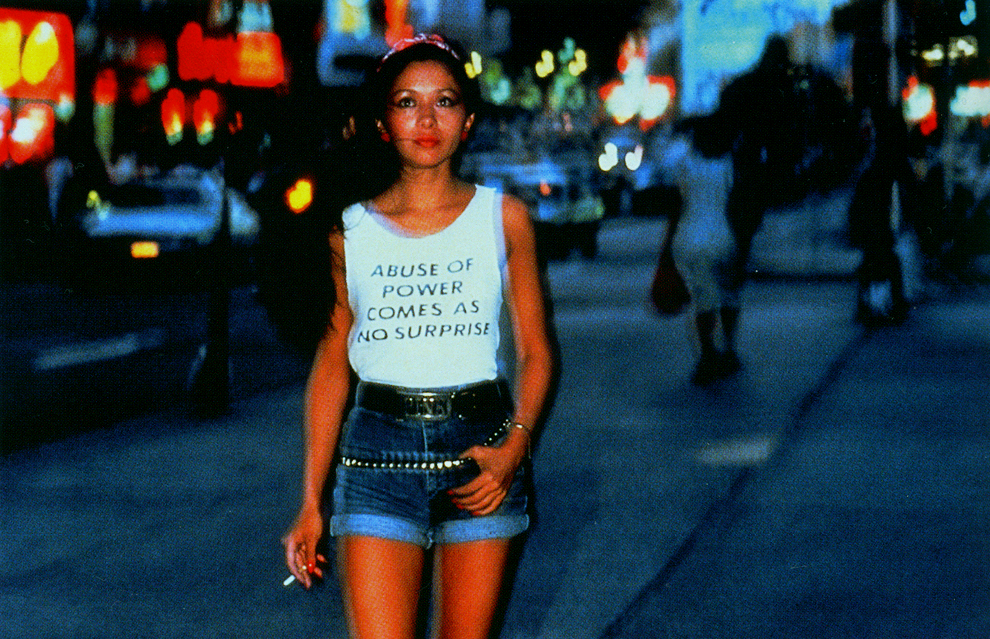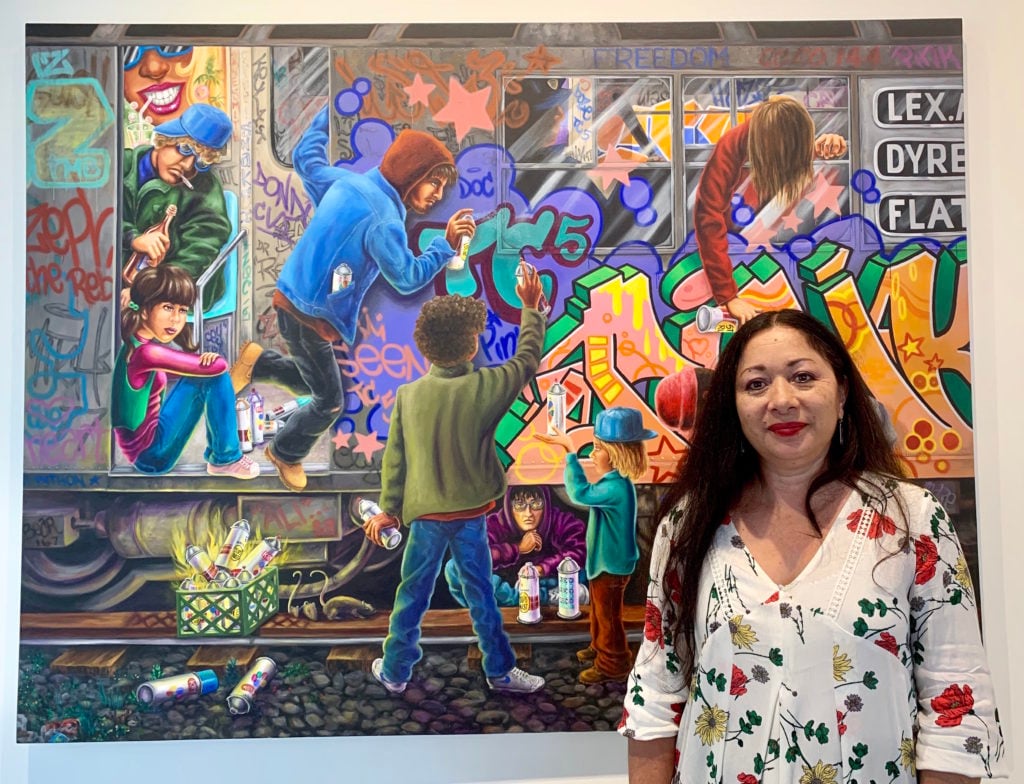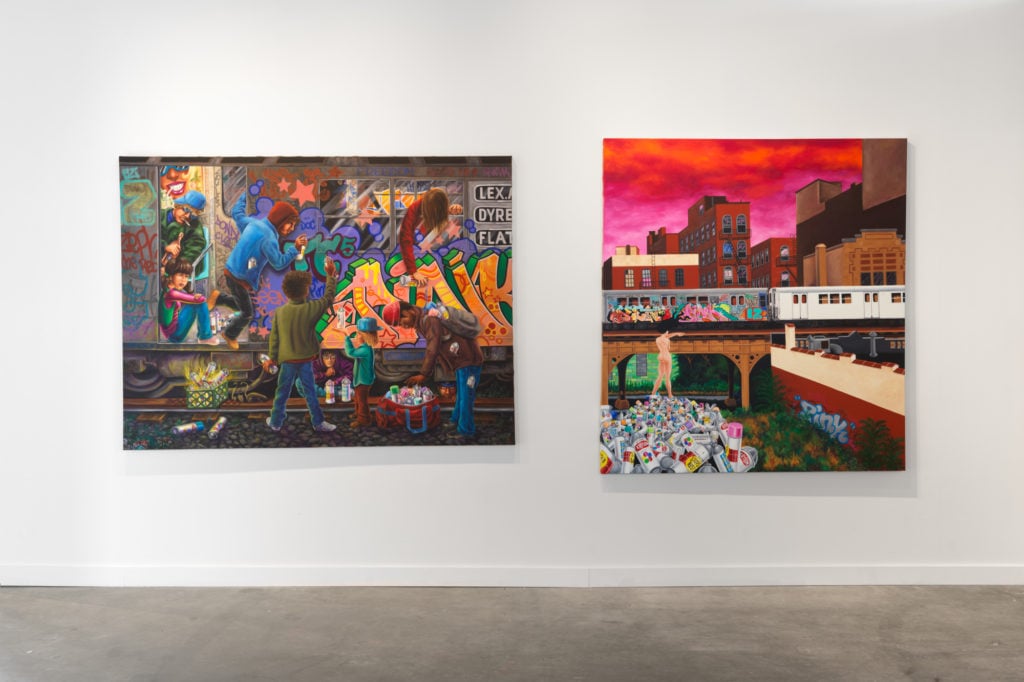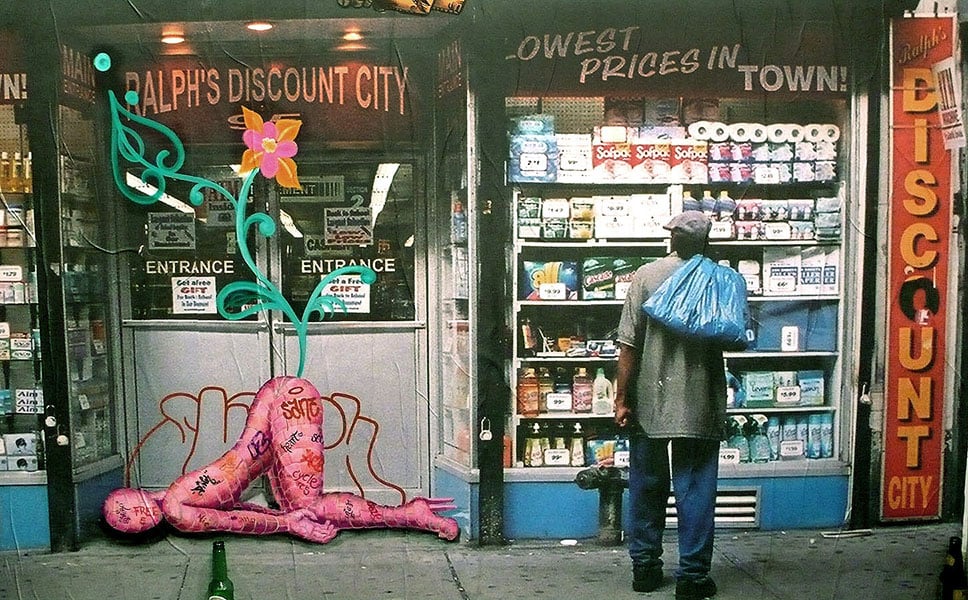On View
‘I Was a Feminist and I Didn’t Know It’: How Lady Pink Made a Space for Herself in the Boys Club of New York’s Graffiti Scene
The artist is part of Roger Gastman's new street art exhibition in Brooklyn, "Beyond the Streets."

The artist is part of Roger Gastman's new street art exhibition in Brooklyn, "Beyond the Streets."

Graffiti historian Roger Gastman’s sprawling ode to the history of street art, the Brooklyn exhibition “Beyond the Streets,” pays homage to the giants of the genre, including Shepard Fairey, Futura 2000, REVOK, and Rammellzee. But while the show makes a case for cementing street art’s status as high art, the Ecuador-born graffiti artist Lady Pink, born Sandra Fabara, would have you know that she’s enjoyed that level of acceptance for going on 40 years.
“At the age of 17, I was going to parties with Andy Warhol at some rich person’s house and hobnobbing with people like Keith Haring and Jean-Michel Basquiat. I didn’t even have time for my senior year of high school, because I was exhibiting and traveling the world,” she told artnet News during the exhibition’s opening. “But on the weekends, I was still having adventures with my friends, going to some crazy part of town and painting subway trains, because it was just sheer fun.”
The rare female artist who has carved out a space for herself in the boys club of street art, Lady Pink began tagging trains as a high school freshman, back in 1979. “Seeing your name going by on a train, there’s nothing like it,” she says.
For five years—the shelf life of an active tagger is fairly short—Lady Pink ran with the best of them, talking herself out of trouble with the police and, soon, showing at bona fide art galleries. In 1983, she was one of the stars of Charlie Ahearn’s seminal hip-hop film Wild Style. Today, she’s among the best-known graffiti artists in the world.

Lady Pink with her painting TC5 Teamwork (2018) at “Beyond the Streets.” Photo courtesy of Sarah Cascone.
“It’s become the thing to do, if museums want to get the attention of young people,” Lady Pink said. “If they want to get audiences that come in by the thousands, this is the kind of exhibition that they’re after—they’ve never seen their museums so full. This is hot stuff!”
We sat down with Lady Pink to discuss her rise to fame, the risks she took along the way, and why she considers street art the “world’s biggest art movement” of our time.
How did you get into graffiti at such a young age?
I went to the High School of Art and Design [in Manhattan]. As a freshman, I met [artist] Seen TC5. We’re like one week apart in age. He was one of my first teachers.
It took months to convince them to take me to the train yards, because I was very feminine at times. I was taught, like all Latin girls, how to dress, how to do makeup since the age of 12. I went to school in silk dresses, high heels—I understood why they were reluctant, but I was also very much a tomboy and I could dress like a boy. I was a sturdy, hardy girl, brave and fearless, and absolutely reckless—they told me insane. I didn’t take orders from anyone, so it was hard controlling me.

Lady Pink, TC5 Teamwork (2018) and Death of Graffiti 3 (2018) in “Beyond the Streets.” Photo by Dan Bradica, courtesy of Beyond the Streets.
Throughout art history, many women artists have tried to obscure their gender. Why did you chose to highlight it with the name Lady Pink?
My boy Seen, I came to school one day, and he was like, ‘this is your name now.’ It was the scene that chose Pink for me. Guys wouldn’t write it, because hip hop and graffiti were always very homophobic. It was well-known that [Pink] would be a girl, and they wanted to be known around the city that they were the only group with a girl.
And you can stylize the letters. With graffiti writers, sometimes the name means absolutely nothing, but the letters look really cool together. With the ‘P,’ you can do stuff before it without destroying it, the ‘K’ kicks out and you can do designs after it, and the ‘I’ is great because you can dot it with a heart for something feminine.
I titled myself, that I chose. I used to read a lot of historical romances about European nobility, duke and duchess this and marquis that. So I titled myself Lady Pink, because we were royalty. We had the most popular table. They treated me like a queen. I’d snap my fingers, some kid would go fetch me food. That was high school. Honestly, I spent like four hours at the lunch table.
As a woman, were you accepted in the street art community?
I had equal amounts of hostility—well, maybe a little more hostility—and acceptance and support. CRASH invited me to be in the first graffiti exhibit, at Fashion Moda, in December 1980. I had just started high school a few months before that. These guys [in the exhibition] were my heroes. I looked up to them like “God I wish I could meet those guys.” Then boom, I’m exhibiting with them.
It was scarier to [paint] in the daytime than in the middle of the night in a train tunnel. It was so dark we got chased. It was freezing cold, I was so drunk—you have all kinds of excuses why your shit didn’t look all that in the middle of the night, but in the daytime, come on. Literally I was too nervous to do straight lines.
My very first piece, my friend Lee [Quiñones] outlined it for me. That’s the only time I ever let a guy do that for me. I was so young and I was so nervous. After that, in the company I was keeping, I had to get good fast!
My first love was Lee—he’s the king of graffiti. We were together for four years. Lee tried to crush me and mold me to the way a man thought a girl should be. I was saying “hell fucking no, I’m making my own decisions and running my own life. I’m not under some man’s thumb.” I was a feminist and I didn’t know it, so it was a lot of clashing and fighting.
Are you and Lee on good terms now?
Yeah, we’ve been exhibiting in the same galleries for 40 years, so we had to get over that. It took me awhile though! I had nightmares of him for years.
What was the craziest thing that happened back when you were a young artist painting trains?
There were a lot of scary events. Just getting to the worst neighborhoods of New York City in the middle of the night as a little tiny 90-pound girl was scary enough. I traveled with a knife—if you clean your nails with a knife on the subway platform, guys will leave you alone. You should know that.
But there were crazy missions. I lost my friends in the train yard, I’d hear screams. Your friend falls through the elevated train tracks, down into the street below, breaks a leg. One night we thought we found a dead body. It was just a piece of machinery, but we thought it was a dead body lying under a tarp on the train. There were some scary incidents, chased by the police and you barely get out alive and go home battered and bleeding. All kinds of adventures like that.
For you, street art was from very early on an entree into the mainstream art world. How have you seen society’s reactions to graffiti shift over the last four decades as street art has become more trendy?
The average person’s perceptions have changed a bit—except when it appears on your building or on your block and the property values start to go down. But the authorities haven’t changed their views: it’s still vandalism, and when it’s done legally [they think] it only inspires vandalism.
I have been stopped by the vandal squad and told to stick to my little interior galleries and make my money that way, to quit painting these big paintings outside, because I inspire young people to do vandalism. And I say, I inspire everyone, from poets to illustrators to photographers to other artists. I inspire the community. If I wanted to inspire vandalism, I’d do tagging, wouldn’t I? I’d do lots of tagging. But no, I don’t. I do big murals, beautiful illustrative works. I put it up there for the world to see, this is how it’s done.
How have you seen the appreciation for street art increase over the course of your career?
We were one of the first groups to come out in this neighborhood [Williamsburg] in 1999 I believe. We did a two-story mural two blocks from here. It’s long gone. But we were given permission by the landlord when he found us working on another building. That’s how it always happens. We’ll be painting and other landlords drive up and say “please, paint my building, paint my building.” After 30 years of graffiti and tagging on their buildings, the only answer is to invite some professional graffiti artist to come in and do something worthwhile and beautiful, because the young cats will respect that.
We don’t normally go and destroy masters’ work—unless we have a death wish! I don’t mean literally, I mean unless you want to see all your work disappear. This isn’t just random scribbling on the wall. We have protocol, we have ethics, we have a code of conduct, we have a hierarchy. It’s a very well-constructed subculture. And when I came in in ’79, that was already in effect. I had to learn all that.
On the other hand, it was a landlord that destroyed 5Pointz, the sanctioned graffiti complex in Queens. What is the status of that case, and the $6.7 million collectively awarded to you and 20 other artists whose work was lost?
It’s being appealed, and right now it’s in the judge’s hands. The arguments have been sent in, both sides, and in the fall we should hear what’s up. The money was put in an escrow account, so it will be released to the artists if it goes our way.
I’m not one to be suing landlords or anything like that, but this was a special case. Those 20 artists were looking up to me to be part of it because I was the most respectable one of the bunch. We had to set a precedent that we are artists of worth and of value, and we are not to be taken lightly. Museums around world label us as contemporary art, and seeing an exhibit like this, there is no doubt.
After 5Pointz was buffed, I only saw it on the news, because I had already moved out of the city. I didn’t see it for real. When I did see those new buildings, I started to cry. The way Meres [One], the director of 5Pointz put it, even the toughest grown men would see it buffed and just start to cry. That just breaks your heart when you see the toughest of the tough, tough as nails dudes, break down in tears.
That place was a mecca. It was amazing. I sent hundreds of artists to paint there. And Meres would give everyone a spot, no matter what age.

A work by Lady Pink done for “Mom & Popism,” a 2009 Gawker Artists exhibition on the Gawker Media roof, based on the photos from James and Karla Murray’s book Store Front – The Disappearing Face of New York. Photo by James and Karla Murray.
Is there a downside to street art and graffiti having become so widely accepted and appreciated?
Absolutely not. This is how we’re earning a living, this is how we survive. The artists with talent should be paid their due. I’m not a purist. We call those purists, who don’t think we should earn a buck. And we’re preserving the history of the last quarter of the 20th century in New York City. That is why they give us exhibitions.
But do you miss the old days when you were first coming up?
You feel nostalgic the way you do for your long lost childhood. Sure, those were carefree, fun-filled, and exciting times, but you can’t go back. I miss those days and I wish I could have done more crazy adventures like that, but it was all extremely risky. Kids got hurt, kids got arrested, kids died, kids got their lives ruined. It wasn’t the best or the safest hobby for a teenager! But I do feel nostalgic for those days. It was all fun, fun, fun and now it’s all work, work, work.
Your work is known for its celebration of women. Why is that theme important to you?
Apparently I was a feminist before I even knew what the word was. As a teenager, I had to hold it together for all the other ladies. There were a lot of girl writers in my high school. They drew in books, but they never went out on the trains. They all looked to me to do those missions because I was the bravest one. I had a lot of girls looking up to me.
I was inspired by pop culture of that decade, like Marcia Brady standing up for herself. My heroes were even those silly girls from Charlie’s Angels. You didn’t have be a crazy dyke in order to be strong and powerful. You could be well-coordinated and feminine and beautifully made up, and you could kick ass in high heels. Those girls inspired me to not let men run all over me. A lot of those female themes are in my work because early on I could see we haven’t reached equality. We don’t get paid the same, and we don’t get treated the same.
Also, I like girls because I like girls! I lived with my girlfriend for about nine years; I’ve been married to a guy for 25 years, so I’ll go both ways. I like girls for other reasons than just empowering women. You know, girls are cute! But it’s all just about inspiring younger artists and women. That I can empower other women to do their thing is absolutely priceless. It keeps me going, it keeps me painting.
“Beyond the Streets” is on view at 25 Kent Avenue, Williamsburg, Brooklyn, June 21–August 2019.